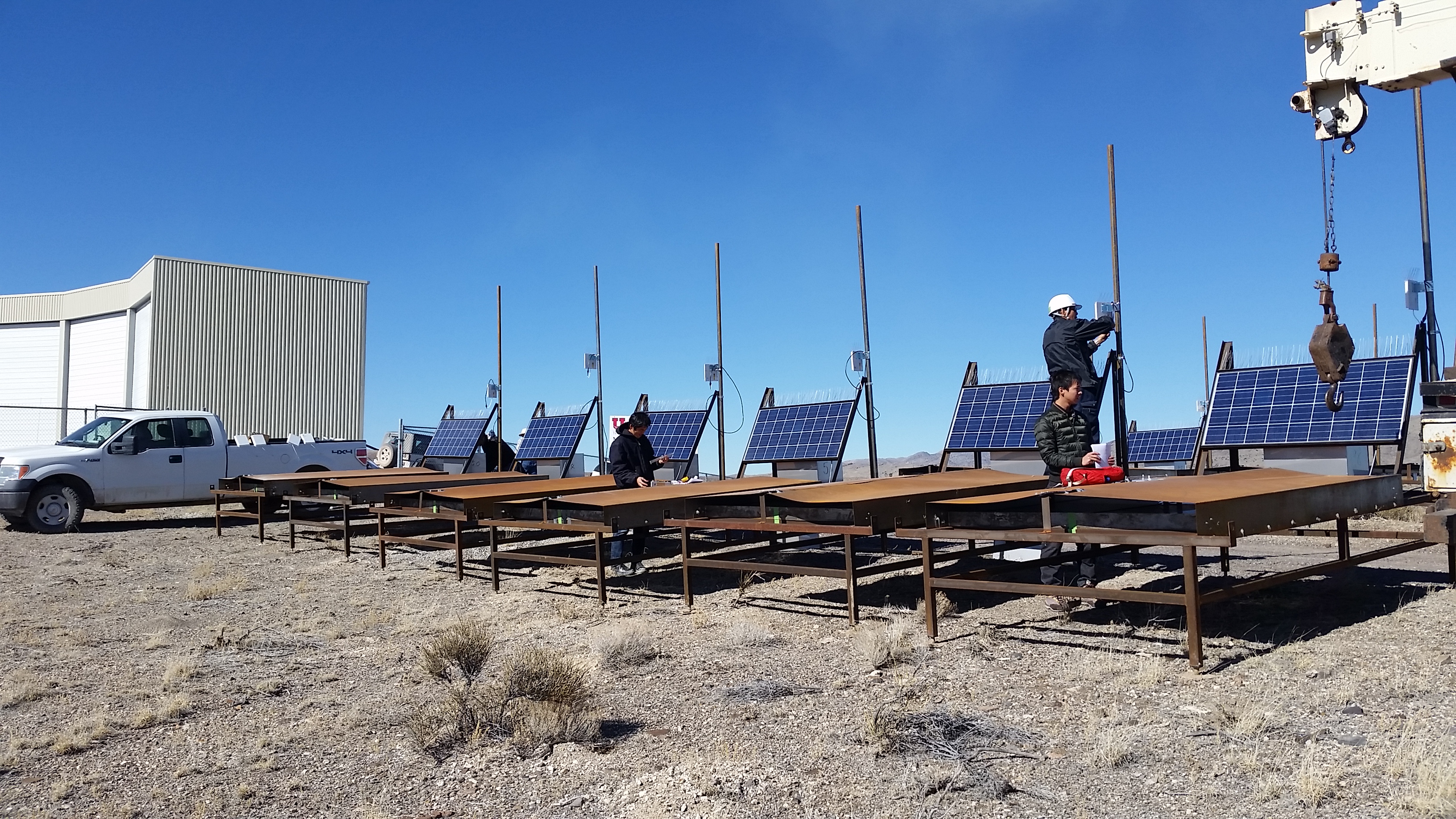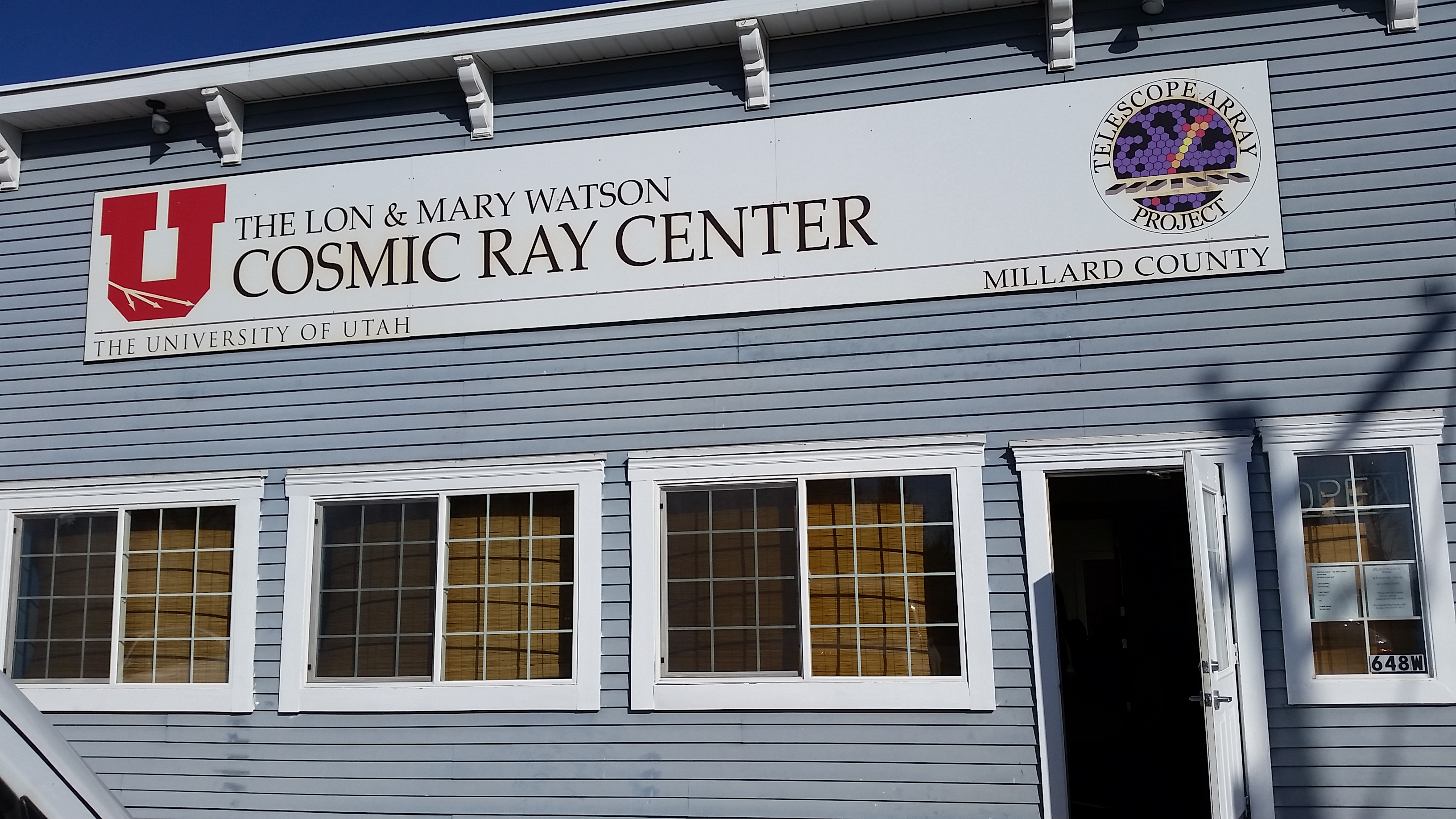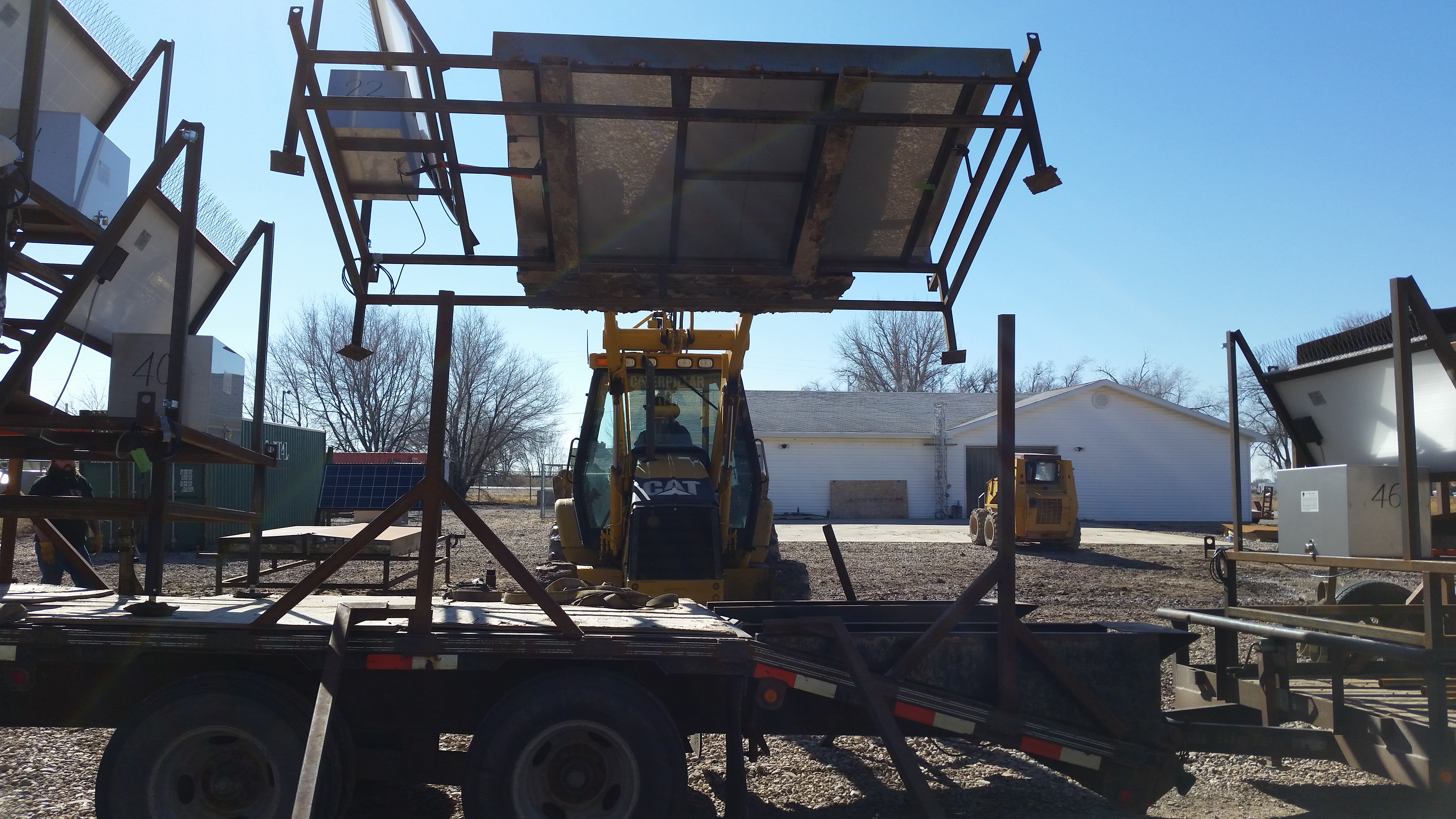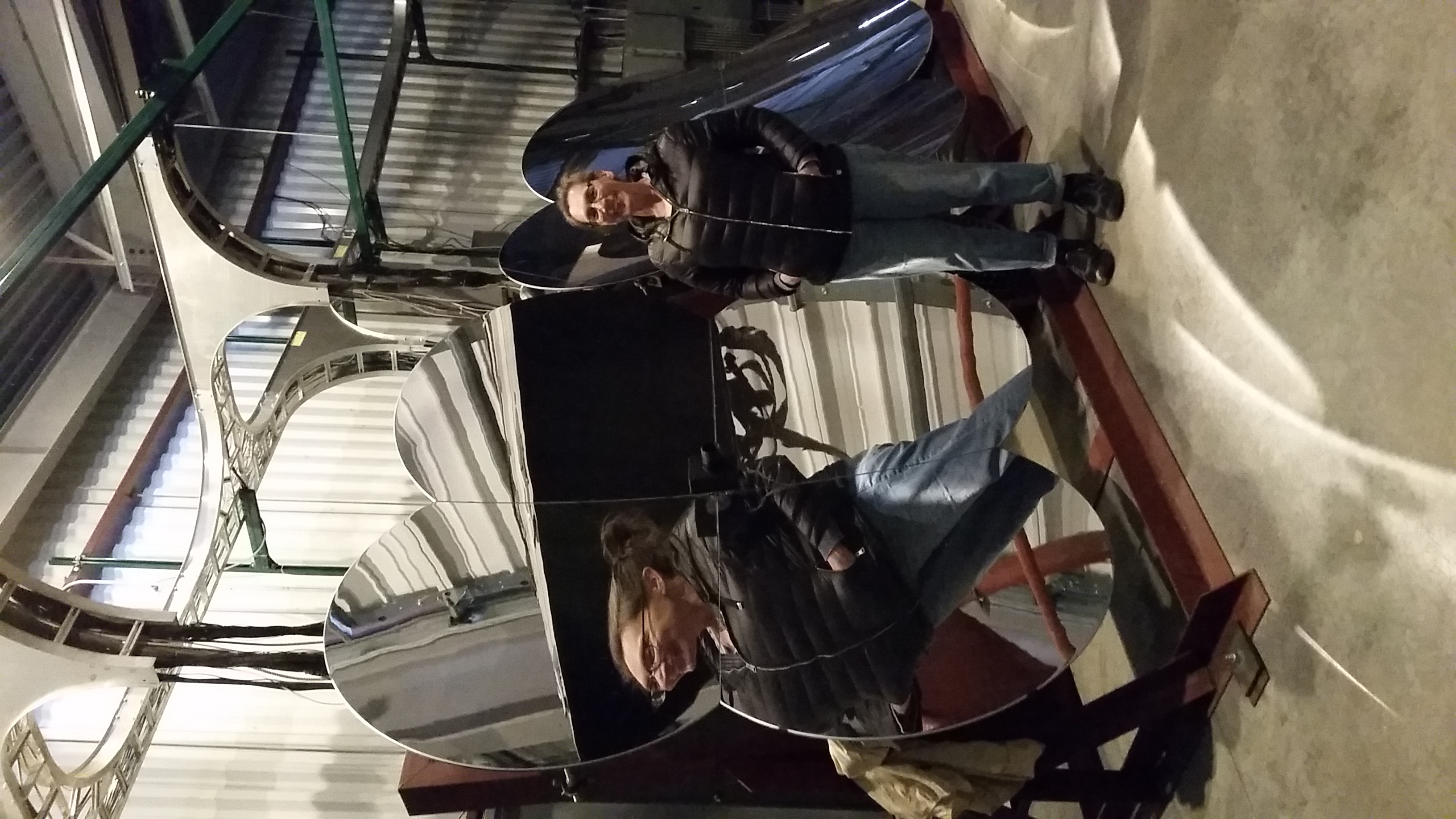Hotspot for Cosmic Rays: Touring the Telescope Array Project in Utah

An unconventional telescope spreads across Utah's dry Bonneville lake bed. Made up of hundreds of giant rusty detectors, the instrument studies cosmic rays, the high-energy particles that come from distant universal sources and Earth's atmosphere.
The Telescope Array (TA) project is made up of instruments that collect the particles produced when cosmic rays collide with charged particles in the air. The desert air makes the site ideal for this kind of work, because it's free from the humidity that might interfere with the paths of the particles tracing cosmic rays. Nearby, a giant telescope searches the horizon for flashes of ultraviolet light, invisible to human eyes, that indicate those initial collisions as well as from the secondary particles.
By studying the particles that cascade to Earth, scientists can learn about the energy of the original cosmic rays. Traveling through space, the cosmic rays are rapidly accelerated to energy levels millions of times higher than particles inside the Large Hadron Collider, the most powerful particle accelerator ever built. [The Telescope Array Project: A Photo Tour]
It's known that some cosmic rays are accelerated by exploding stars called supernovas, and -low-energy cosmic rays are ejected from "ordinary" stars, similar to our sun, by solar flares that explode off the star's surface. But the source of high-energy cosmic rays remains a mystery. Large, energetic structures with strong shocks, such as the active centers of galaxies, are one potential source. Learning more about the rays may help scientists uncover additional sources of cosmic rays, and shine light on the process (or processes) that accelerates them through space.
The Telescope Array project is already off to a good start. In 2014, the project noticed that cosmic rays seemed to be in a greater cluster in the sky just south of the Big Dipper.
"What we're looking for are those incredibly rare events," Julie Callahan, project coordinator at the University of Utah who works on public outreach for the TA project, told Space.com.
In February, Callahan and I made the 2.5-hour drive from Salt Lake City to Delta, Utah, where scientists are hunting for answers to the mysteries about cosmic rays. We then ventured even farther away from civilization, making the 45-minute trek to the Telescope Array project's Middle Drum observatory, home to the giant telescopes and surrounded by the "scintillation detectors" (SDs) that operate around-the-clock.
Get the Space.com Newsletter
Breaking space news, the latest updates on rocket launches, skywatching events and more!
The trip to nowhere
Callahan picked me up just south of Salt Lake City for the long drive to the project. The city, nestled in a valley surrounded by mountains, doesn't seem like a good site for night-sky observation. During the winter, Salt Lake City has what the locals refer to as "the inversion," where the surrounding mountains allow a cap of warm air to trap pollutants in the valley, creating a long-lasting gray cover over the city and nearby suburbs. The journey to the array will take us far from this atmospheric effect, though we'll be able to pick it out from 3 hours away.
As Callahan fills me in on the project, the suburbs melt away to a flat, scrub-filled desert with an occasional rocky mountain poking up unexpectedly. Eventually, we reach the small town of Delta, home to the Lon and Mary Watson Cosmic Ray Center, which serves as a base of operations for the Telescope Array (TA). The small concrete-block building sits just off the road, its side yard filled with strange rusty objects. A small sign on the building reveals the TA's purpose — hunting cosmic rays.

Led by the University of Utah, the Telescope Array project is composed of 28 international collaboration partners, including 19 institutes and universities from Japan. The Asian influence is obvious as I tour the site, especially in the storage room where boxes of parts and partially assembled scintillation detectors are stashed. While some of the boxes are marked in English, far more are labeled in Japanese, with no English translation, and many of the signs are also written in Japanese.
When I walk into the center, I'm greeted by a small visitor's area. Callahan, who arrived at her present position with an art background nearly two decades ago, helped to design the lobby's three-wall mural, which features an illustration of the desert and sky that surround the scintillation detectors. Posters describe the work being done by scientists working on the TA project, and a comic book uses manga (a Japanese illustration style) to provide even more detail about the science going on here. The fourth wall is a homage to the nearby Topaz internment camp that imprisoned Japanese-American citizens during World War II.
It's through the next door, however, that the work gets done. The middle of the building is a single giant room, divided in half by a partition lined with desks and decorated with posters. A pair of scintillation detectors sits on the left side of the room, under construction. On the right side are desks covered with electronics that make up the guts of those detectors.
Despite it being a weekday, there are only two men inside the building, doing basic custodial work. One is American, and the other speaks only Japanese. Everyone else is out in the desert at the Middle Drum facility.
After more than a decade, the project is receiving its first major upgrade of over 100 closely positioned scintillation detectors to hunt for cosmic rays at lower energies. Known as the Telescope Array Low Energy (TALE), the project requires placing the detectors closer together. A third of the new detectors will sit a quarter-mile (400 meters) apart from each other, and another third will be spaced a third of a mile (600 m) apart from each other. With three-quarters of a mile (1,200 m) separation, the last batch will have the same distance between them as TA's detectors. Another planned expansion, dubbed Telescope Array Times Four, will double the number of TALE detectors and quadruple the ground covered. According to Callahan, the success of the 2014 finding paved the way for the expansion by proving the project's scientific merits.
We pass through strips of clear plastic hang from the top of alarge opening that connects the rooms. The wide space allows a Skid-Lift to drive in and pick up the 1,200-pound detectors. At the back of the building, a raised garage door opens up to the outside. In a mud-filled corral behind the building sit rows of new detectors, awaiting transport to Middle Drum.
Over the past few months, the team has been assembling the new scintillation detectors in preparation for the upgrade. From the corral, they will be trucked to the Middle Drum site, a remote, uninhabited location 45 minutes from Delta. The final deployment will require a helicopter to deliver the detectors to their resting places, and moving the detectors to Middle Drum by truck will reduce the flight time (and subsequent cost), while keeping the helicopter noise from bothering Delta's population.

Helicopters are a necessity for the upgrade. The project sits on public lands where vehicles must remain on roads; even bicycles are forbidden to go off-road. The team has occasionally rented horses to visit multiple scintillation detectors, but most of the time, they park on the nearest road and hike in to make checkups or repairs.
As I squish through the corral's thick mud, I'm greeted not by shiny new detectors but by rusted hunks of metal. The rust is a deliberate effort to avoid distracting the Air Force pilots that often fly over the desert, Callahan said. The boxes look like rusted hospital bed frames; Callahan said her husband compares them to pingpong tables.
The heart of the scintillation detector lies within the box on top of the frame. Two panels cover the box, and require several people — and a special grip — to open them. Inside sit two layers of a plexiglass-like acrylic material doped with a molecule that creates ultraviolet light when hit by a charged particle from a shower of particles created by a cosmic-ray collision in the atmosphere. Rows of fiber-optic cables inside of grooves gather the light and amplify the signal, which is sent back to the electronic portion of the detector. Antennae broadcast the data back to the Cosmic Ray Center for the scientists to observe. On top of the frame, solar panels power the whole system. Small wires above them keep the local birds, which include various raptors such as golden eagles, from sitting on the detector and pooping on the panels.
The scintillation detectors don’t sit in the corral for long after I arrive. I watch as a batch of them are loaded two-high and three-wide onto a trailer and carried out to the Middle Drum site. It took two days to transport all of the TALE detectors.
At Middle Drum, a local contractor and his team used a crane to lift the detectors from the truck and line them along the roadside. The following week, helicopters will arrive to carry them to their final homes in the desert.
'We could melt glass'
While the scintillation detectors will operate in the desert every hour of every day, the optical instruments at Middle Drum function only on clear nights with no moon. Two large buildings house the telescopes. The first building is home to the Telescope Array fluorescence telescope, which targets the horizon. The telescope's mirrors resemble those of a giant optical telescope designed to study distant stars, but this instrument is designed to look for ultraviolet light created by atoms in the Earth's atmosphere when they interact with cosmic rays.

In the second, taller building, the TALE telescopes target higher skies than their TA counterparts. Although the cosmic rays TALE will study still fall in the high-energy realm, they are less energetic than those identified by TA. The decreased energy means the showers end higher in the atmosphere, so TALE's telescopes peer above the horizon, looking for those faint ultraviolet flashes that occur when the cosmic rays collide with particles in the atmosphere.
The pair of buildings at Middle Drum tower over the desert, with exterior automatic doors stretching about 20 feet high, with only a few feet to the roof. TALE’s telescopes point higher into the atmosphere than TA’s, requiring greater height for the doorways through which they peer.
The two massive buildings are sealed tight. We pass through an office area where someone sits to monitor the fluorescence telescopes. Unlike the scintillation detectors, which aren't affected by light, the fluorescence telescopes are sealed off from sunlight during the daylight hours, because sunlight can permanently damage the mirrors. A sign on the door reminds us of the danger direct sunlight has for the instruments, and includes the image of a person having their face melted in the movie "Indiana Jones and the Raiders of the Lost Ark." This light sensitivity is so extreme, a sign on the road to the site requests that headlights be turned off and that flashlights be used with a red filter.
Each telescope consists of four round optical mirrors combined in a cloverleaf pattern. When the garage doors open on clear nights, the 3-inch mirrors collect light and focus it on a collection of 256 photomultiplier tubes. The channeled light should reveal any flashes on the horizon from cosmic rays. Like a powerful magnifying glass, it results in a very focused beam of light.
"We could melt glass with this thing," said Robert Cady, an assistant research professor at the University of Utah, who is working on the experiment.
Whenever the telescopes are operating, two people must be on site in case there's a problem. (With the telescope sitting in the middle of nowhere, safety concerns mean that no one is permitted to be at the site alone.) Most of the time, the work for those two employees is boring, Cady said, but their presence is necessary to protect the instruments.
"When something goes wrong, it goes really badly wrong," he said.
Among other things, the folks at the site must check the enormous garage doors to make certain they shut completely at the end of a run. If a mechanical issue keeps them from closing, each mirror must be covered. The tool of choice is king-size fitted sheets, which, Cady said, work perfectly.
Once or twice a year, the mirrors are washed to remove any accumulated dust, but the work must be done carefully to avoid scraping off the aluminum cover, Cady said.
Each cloverleaf sits on a metal frame, with its computer controls in a locker behind it. Everything in the giant warehouse is raised off the floor, thanks to lessons learned from a previous project, which suffered a rodent problem.
"Rats love to chew cables," Cady said. "We keep everything rat-proof, off the ground."
Hard to replace
Even though they're out in the middle of a desert, a few of the scintillation detectors have had to be replaced. A wet winter several years ago resulted in flooding, and several of the detectors were immersed. Cady and a colleague went out in a kayak to check on the instruments, and some had only their antenna sticking above the water. Those were trashed, and now sit in the corral. Another one was damaged in an auto accident when a motorist unaffiliated with the project crashed into it.
Simple exterior repairs can be made to the scintillation detectors in the field, but major repairs require them being taken back to Delta. There, the team can repair or replace major components in controlled conditions, without having to haul everything out to the middle of the desert.
While the detectors are inexpensive to replicate, the mirrors are another story. According to Cady, the equipment and space used to fabricate them no longer exists. So, while the mirrors themselves cost only a few thousand dollars, he estimated it would take more than $100,000 to get set up to build more. Fortunately, the project has 30 to 40 more mirrors in storage in Salt Lake City.
According to Cady, the biggest emergency event came at the beginning of the project, when three members of the team flipped their pickup truck in the desert. The helicopter that was placing the detectors carried the three into town, where an ambulance transported them to the hospital. All three survived.
Other problems include occasional wind damage to the detectors. Far more likely is that one of the team members will wind up stuck in the desert due to car trouble.
"We have the local mechanic on speed dial," Cady said.
Callahan often interacts with the people in the county, making sure they have an idea of what the giant array is doing. She sets up a booth at the state fair every year and welcomes the opportunity to share details with anyone who is interested in the Cosmic Ray Center.
The hunt for cosmic rays requires a location with a thin, dry atmosphere where secondary particles can travel easily to the detectors, which usually means deserts at high altitudes. Similar sites have been set up in Mexico, South America and Antarctica. There have also been cosmic-ray detectors on the International Space Station, which collect the actual cosmic rays and not secondary particle showers. Among these, the Telescope Array has perhaps the best location, only 3 hours south of Salt Lake City's airport, Callahan said. In addition, she's grateful for the support from Delta's community.
"There are only a few places in the world where you can do this kind of work," she said.
Follow Nola Taylor Redd on Twitter @NolaTRedd or Google+. Follow us at @Spacedotcom, Facebook or Google+. Originally published on Space.com.
Join our Space Forums to keep talking space on the latest missions, night sky and more! And if you have a news tip, correction or comment, let us know at: community@space.com.

Nola Taylor Tillman is a contributing writer for Space.com. She loves all things space and astronomy-related, and always wants to learn more. She has a Bachelor's degree in English and Astrophysics from Agnes Scott College and served as an intern at Sky & Telescope magazine. She loves to speak to groups on astronomy-related subjects. She lives with her husband in Atlanta, Georgia. Follow her on Bluesky at @astrowriter.social.bluesky
